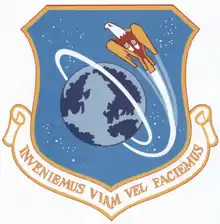Air Force Satellite Control Facility
The United States Air Force's Air Force Satellite Control Facility (AFSCF) was a space command and control unit located at Onizuka AFB, California. It has the distinction of being heavily involved in the world's first reconnaissance satellite program, CORONA. Due to geological hazards (i.e. earthquakes), and the terrorism threat from its proximity to a major transportation link (California Highway 101), the facility's command and control functions were moved to Schriever AFB, Colorado.
| Air Force Satellite Control Facility | |
|---|---|
 Air Force Satellite Control Facility emblem | |
| Active | 1965–1993 |
| Country | United States |
| Branch | United States Air Force |
| Type | Satellite Operations |
| Role | Command and Control |
| Part of | Air Force Systems Command/Air Force Space Command |
| Garrison/HQ | Onizuka AFB, California |
| Motto(s) | INVENIEMUS VIAM VEL FACIEMUS – "We find the road or we make it" |
History
The Air Force Satellite Control Facility (AFSCF) was originally activated at Los Angeles AFS, California on 18 Jun 1965.[1] It was first assigned to the Space Systems Division of Air Force Systems Command, with later moves under the Space and Missile Systems Organization, and Space Division organizations.[1][2]
Previous designations
- Consolidated Space Test Center (2 Oct 1987 – 27 Aug 1993)[1]
- Air Force Satellite Control Facility (18 Jun 1965 – 1 Oct 1987)[1]
- 6594th Aerospace Test Wing (1 Nov 1961 – 1 Jul 1965)
- 6594th Test Wing (Satellite) (15 Jan 1960 – 1 Nov 1961)
- 6594th Test Wing (6 Apr 1959 – 15 Jan 1960)
- Field Office of Air Force Ballistic Missile Division (15 Aug 1958 – 6 Apr 1959)
Assignments
Major Command/Field Operating Agency
- Air Force Space Command (??-27 Aug 1993)[3]
- Air Force Systems Command (1 Jul 1965-27 )[4]
Elements assigned
- 6594th Aerospace Test Wing (6 Apr 1959 – 1 Jul 1965)
- Detachment 1, Donnelly Radio Relay Site, Delta Junction, Alaska (15 Apr 1962 – 1 Jul 1965)
- 6594th Support Group (1 Jul 1965 – 1 Oct 1987)
- 6594th Recovery Control Group (1 Jul 1965 – 30 Sep 1986)
- 6594th Launch Squadron (1 Jun 1959 – 15 Jul 1961)
- 6594th Data Processing Squadron (1 Jul 1959 – 1 Oct 1960)
- 6596th Instrumentation Squadron, Vandenberg AFB, California (1 Jul 1959 – 30 Jun 1972)
- 6594th Instrumentation Squadron (1 Oct 1959 – 1 Jul 1965)
- 6595th Test Squadron (20 Feb 1961 – 1 Jul 1965)
Detachments
- Det 1 – Sunnyvale, California (1 Jul 1965 – 1 Jul 1977)[1]
- Det 2 – Vandenberg Tracking Station, California (1 Oct 1979 – 1 Oct 1987)[1]
- Det 3 – Thule Tracking Station, Greenland (1 Oct 1979 – 1 Oct 1987)[1]
- Det 4 – Mahé, Seychelles (15 Jul 1972 – 1 Oct 1987)[1]
- Det 5 – Guam Tracking Station, Guam (1 Oct 1979 – 1 Oct 1987)[1]
- Det 6 – Hawaii Tracking Station, Hawaii (1 Oct 1979 – 1 Oct 1987)[1]
- Det 7 – Sunnyvale AFS (later Onizuka AFS), California (17 Apr 1987 – 30 Sep 1987) (later moved to Los Angeles AFS, California from 30 Sep 1987 until inactivation on 15 Jul 1991)[1]
Bases stationed
- Sunnyvale AFS (later, Onizuka AFS/AFB), California (8 Jul 1977 – 27 Aug 1993)
- Los Angeles AFS, California (18 Jun 1965 – 8 Jul 1977)
Spacecraft Operated
- KH-1/2/3/4 CORONA (1959–1972)
- Global Positioning System (GPS)
- Fleet Satellite Communications System (FLTSATCOM)
- Various satellites of the Space Test Program
References
- AFHRA FOIA Request 2009-02203, 21 July 2009
- Wikileaks: "NRO Blue Cube Deactivation", 7 Mar 2007
- Air Force Historical Research Agency Fact Sheet: Air Force Space Command factsheet Archived 25 March 2009 at the Wayback Machine
- "Air Force Historical Research Agency Fact Sheet: Air Force Systems Command factsheet". Archived from the original on 19 February 2013. Retrieved 25 July 2009.
- World Airpower Journal. (1992). US Air Force Air Power Directory. Aerospace Publishing: London, UK. ISBN 1-880588-01-3
